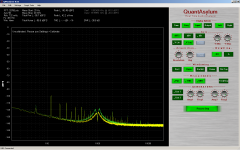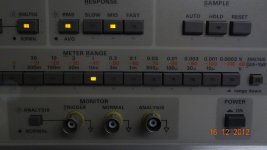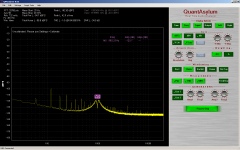10kOhm in 22kHz bandwidth has -114dbV noise -you will get this with 100kohm 10:1 input attenuator
for the power amp you can put 100 Ohm 10:1 input attenuator and obtain -136dbV noise if your front end has 1nv/sqrtHz
Samuel is right, having -130/-140 dB THD+N and input signal from mV to 100V in mind you can think only about modular design, with separate input modules optimized for each input voltage/impedance range
for the power amp you can put 100 Ohm 10:1 input attenuator and obtain -136dbV noise if your front end has 1nv/sqrtHz
Samuel is right, having -130/-140 dB THD+N and input signal from mV to 100V in mind you can think only about modular design, with separate input modules optimized for each input voltage/impedance range
Last edited:
Right.
Hi Rick,
You haven't a hope of ever getting that from 339a or anything like it.
You would start with with a noise floor of -160db at least. The distortion doesn't add nearly
as much to that as the wide band noise. I have de-tune the notch filter in the 339a enough to raise the fundamental 15db before it start to show up on the meter with a measure floor of 0.0012%. Once this is done the disto measurement is right on. The limitation of the 339a is the noise. Otherwise we would have to add an decade range to the measurement.
We are better off finding an instrument that can measure the THD+N with out amplification rather than having to add 80dB of gain so a meter can display it. Today's ADC's are getting close but have a ways to go. These cheap little audio ADC's haven't a chance but are good enough for GP work. After all there isn't a lot that do what they can. I think we need to look at the industrial stuff.
Cheers,
Does anyone know of a complete digital control of amplitude and phase for a notch filter?
This includes amplitude and phase measurements.
Cheers,
Digital control "servo" for an analog notch filter? Or a digital filter? I think all the current solutions, including the AP, are analog. The SRI has analog preprocessing and digital filtering. The R&S is similar.
AKM has a scheme for "bonding" multiple ADC's to get greater dynamic range. I think the app note got to -126 dB wideband using 4 ADC's. I can post it if I can find it.
Digital control "servo" for an analog notch filter? Or a digital filter? I think all the current solutions, including the AP, are analog. The SRI has analog preprocessing and digital filtering. The R&S is similar.
AKM has a scheme for "bonding" multiple ADC's to get greater dynamic range. I think the app note got to -126 dB wideband using 4 ADC's. I can post it if I can find it.
Hi Demian,
I mean digital control of an analog notch filter.
The AP is SVF I think. I'd like to see something using other filter types but the measurement is all essentially the same.
It would be ideal to do this using a set of SVF and SVO because the quadrature is available off the oscillator. However it would be limited to the set unless the an external oscillator was synchronized to the internal SVO of the set.
Yes please post anything you have.
Cheers,
let's narrow the issue down to: 1volt and 10Vac input; 1K and 100 Ohm Z input. If just one -- 1v/1k. How close can we get to -130+N ?
I dont expect the 339A to get us there. the idea of redistributing the gains will do wonders, i'm sure. And, that would be about IT for the 339A. Pretty good upgrade results for low bucks and one doesnt have to build the box, power supply and all the guts. If I had to do all that, I'd rather go hang myself in the morning.
The 339A is about the cheapest instrument that DIY'ers will ever be able to do simple modes to (parts, value changes and IC replacements) and get excellent results. However, next up the ladder of affordability might be the popular HP 8903_ or others? If the full potential can be realized in that one or other readily available used gear, what rewards will they bring? This little 339A excercise shows us there is a lot that can be had in refurbishing them for improved performance if the fundamental design is sound (?). Thx-RNMarsh
Thx-RNMarsh
I dont expect the 339A to get us there. the idea of redistributing the gains will do wonders, i'm sure. And, that would be about IT for the 339A. Pretty good upgrade results for low bucks and one doesnt have to build the box, power supply and all the guts. If I had to do all that, I'd rather go hang myself in the morning.
The 339A is about the cheapest instrument that DIY'ers will ever be able to do simple modes to (parts, value changes and IC replacements) and get excellent results. However, next up the ladder of affordability might be the popular HP 8903_ or others? If the full potential can be realized in that one or other readily available used gear, what rewards will they bring? This little 339A excercise shows us there is a lot that can be had in refurbishing them for improved performance if the fundamental design is sound (?).
Last edited:
AKM has a scheme for "bonding" multiple ADC's to get greater dynamic range. I think the app note got to -126 dB wideband using 4 ADC's. I can post it if I can find it.
That is interesting. Could also apply to an existing, older design?.... stack new, multiple ADC's.
Richard -- RE the HP 8903 -- I think it is a poor choice all around. The chain of amps is even longer than in the 339 and the gain structure varies with auto operation in some odd ways, making the monitor output reference level hard to figure out. Plus the filters are absolutely in all the wrong places. I *think* the oscillator may be very good, but I doubt it's better than the 339. But the notch system is certainly no better than the 339's. Not to say that it isn't moddable, but the plug-in card system makes some things more difficult as breaking up and rea-arranging a sequence of amps is quite a challenge -- and then the microprocessor control system goes nuts....
Richard -- RE the HP 8903 -- I think it is a poor choice all around. The chain of amps is even longer than in the 339 and the gain structure varies with auto operation in some odd ways, making the monitor output reference level hard to figure out. Plus the filters are absolutely in all the wrong places. I *think* the oscillator may be very good, but I doubt it's better than the 339. But the notch system is certainly no better than the 339's. Not to say that it isn't moddable, but the plug-in card system makes some things more difficult as breaking up and rea-arranging a sequence of amps is quite a challenge -- and then the microprocessor control system goes nuts....
OK. I believe you. Sounds like a bad example to use. Just thinking outloud - a thought about if there is something better and ready made to upgrade, what might it be? Thx for info -RNMarsh
I'm with you about starting from scratch these days -- time is a bit short. So I cannibalize other stuff. I am going to try to get the active twin-t working with auto-tuning -- I suspect the pull-in range will be small, but I don't care about that -- I'm willing to turn some knobs to get it in range. As I've said, I'm not sure how good the active twin-t is in either total noise or in distortion -- that's the trouble here all the way round -- everything we're concerned about is lower than whale manure....
Difference of 339a range
Rick have a look at this.
The green is 1KHz in the 1K range and the yellow is 1KHz in the x100 range.
The noise floor and notch shoulders are lower in the x100 range.
The padding resistors and filter resistors are lower in value and the caps are larger in the x100 range.
Rick have a look at this.
The green is 1KHz in the 1K range and the yellow is 1KHz in the x100 range.
The noise floor and notch shoulders are lower in the x100 range.
The padding resistors and filter resistors are lower in value and the caps are larger in the x100 range.
Attachments
Congrats on that. They are quite rare. We need to see how different yours is from my much older one.
There is someone on the web with a rentable manual.
You will now need the matching oscillator. I can lend you one for a while.
Sent from my myTouch_4G_Slide using Tapatalk 2
There is someone on the web with a rentable manual.
You will now need the matching oscillator. I can lend you one for a while.
Sent from my myTouch_4G_Slide using Tapatalk 2
Take the week off! Drinks are on me ! The ShibaSoku AD725D has arrived. .0003 full scale. I'll check the 339A source today. [Now if I just had a schematic] -RNMarsh
Hi Rick,
Here is something to compare it too.
This is the 339A oscillator, with mods and a tight calibration, at it best.
1KHz, 1Vrms. The notch filter in the 339a is seeing 1Vrms from the buffer amp.
Cheers,
Attachments
Very good. David, where 1/f noise is originated: oscillator, input att/amplifier, notch amp/capacitance neutralizer, etc?
Hi Dimitri,
I'm not sure I can put my finger on it. It looks like it's a bit of all of the above mentioned.
Some of the answers can come from calculation and the rest has to be measured.
Resistor noise we can calculate or just say we have a 100K input impedance and so that is a source. But this is in parallel resistance with the source resistance which is 600 ohms. This impedance changes with input attenuation as seem by the input of the amplifier. At 0dB attenuation we have the source but as we change input attenuation we have something different at the amplifier input. This effect can be seen by reducing the oscillator output level and changing the input sensitivity. The 339a meter rises for the same voltage seen by the amplifier's input. We also have a gain change on this amplifier as the input sensitivity is changed.
I would say the most noise is generated by the notch filter control elements. The LDR's. Another source is the auto set level. The auto set level maintains a constant output level within a 10dB range of the input range selector. it also has an LDR. At unity it's resistance is very high and is reduced as needed to a max of 10dB increase.
Then there is just the normal contribution of the amplifier noise at what ever gain.
What matters most is the noise at the output of the notch filter. After that it is amplified 80dB, 10000 times. That's a lot. This gain is distributed over the distortion amplifier 30dB, the auto set level 10dB and the meter amplifier just before the RMS detector 40dB.
We can see from the plot in the last post the SW is reporting a total noise power of -94.6dB at the output of the notch filter. -95dB + 80dB is -15dB (0.178mVrms) of noise in a 20KHz of bandwidth. Out of 1Vrms this is 17.78% of noise out of the FS and with all filter, in that's a 29.6KHz bandwidth seen by the meter. 17.78% of 0.01% FS is 0.001778 residual which is exactly what HP states for the 339a.
My answer then is the majority of the noise is from the input stage, the notch filter and or the oscillator /attenuator. I don't think it's the oscillator but it might be. I'm at my measurement noise floor.
Here is a clue. The residual of the level meter with all filters in, on a good day with no signal and input loaded to 600 ohms is about 5uVrms with a 339a option 001.
In level mode the distortion amplifier is bypassed. The chain in level mode is input amplifier + level amplifier + meter amplifier with a maximum gain of 80dB FS. Plus a bit more for option 001.
Cheers,
Very good. David, where 1/f noise is originated: oscillator, input att/amplifier, notch amp/capacitance neutralizer, etc?
The capacitance neutralizer doesn't seem to contribute much noise which I find surprising for a circuit using positive feedback, negative impedance.
Cheers,
- Home
- Design & Build
- Equipment & Tools
- Low-distortion Audio-range Oscillator



